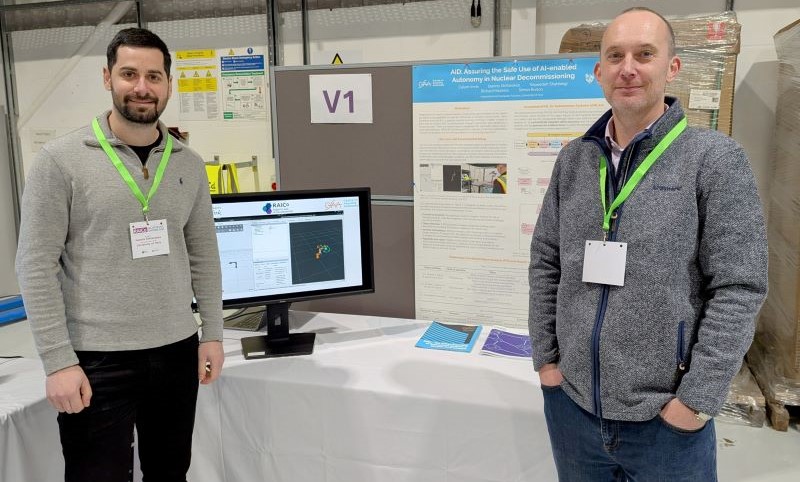Showcasing Safe AI in Nuclear Decommissioning
Posted on Monday 27 January 2025

The project, which started last year and is titled Assuring the safe use of AI-enabled autonomy in nuclear Decommissioning (AID), aims to help tackle the increasingly difficult and dangerous task of decommissioning at nuclear sites. The project is funded by The Robotics and Artificial Intelligence Collaboration (RAICo), which is a collaboration between the UK Atomic Energy Authority, the Nuclear Decommissioning Authority, Sellafield Ltd and the University of Manchester.
In AID, Principal Investigator, Dr Richard Hawkins, alongside Research Associates, Dr Calum Imrie and Dr Ioannis Stefanakos, are investigating how to assure the safe use of reinforcement learning (RL) in a robotic arm that is used to help clean up old contaminated gloveboxes. In nuclear facilities, irradiated material is often processed in these gloveboxes which are sealed compartments designed to contain the harmful radiation emitted whilst enabling human operators to interact safely with the material using inbuilt gloves attached to the sealed glovebox. Robotic arms can also be used in the gloveboxes to interact with the materials through remote operation. By using AI to train the robotic arm to operate independently, we can improve the safety and performance of the operation.
At the showcase, held at the RAICo research lab, the project team shared their progress so far which includes a mock glovebox testbed featuring a robotic arm within the laboratory in the Institute for Safe Autonomy (see images below). This enabled a detailed examination of the robotic arm functions, operating modes, failure modes, and severity classifications. Alongside this the team demonstrated a “digital-twin” software simulation of the arm being used to assist in the RL training. This helps the robotic arm to perform simple cleanup tasks such as safely identifying, picking and moving different types of objects.
Dr Ioannis Stefanakos said: “After setting up the testbed, we then conducted a functional failure analysis (FFA) of the RL functions of the robot arm to identify potential failure conditions, the modes in which they could occur, their effects, and their severity classifications. Building on the outputs of the FFA, we applied a Hazard and Operability (HAZOP) study to the RL component. This systematic process, guided by the system’s architecture, provides a structured framework for identifying and evaluating potential hazards relating to the use of RL. The output from the HAZOP is used to specify the safety requirements for the RL component in glovebox operations. All of which we were able to demonstrate at the RAICo showcase.”
The project is adapting the AMLAS methodology, created in the CfAA, in order to demonstrate the safety of the RL. This requires consideration of the safety requirements for RL, the data and training of the RL component, as well as testing and validation on the real arm and in simulation. This work will support the development of a safety case for the RL that can support its future deployment in real nuclear decommissioning tasks.
Dr Hawkins said: “The use of AI technologies such as reinforcement learning has the potential to help make nuclear decommissioning tasks safer by enabling us to physically separate humans from radioactive material. However, before AI technology can be deployed we have to be able to demonstrate that it is sufficiently safe.
“The AID project is providing a fantastic opportunity for us to better understand how the safety of using reinforcement learning in hazardous tasks can be demonstrated. We are building upon our established AMLAS methodology to provide practical guidance that will also be useful for people deploying RL across other domains.”
